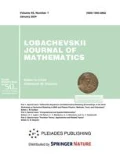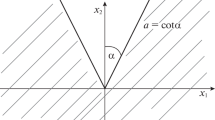Abstract
The paper is devoted to studying limit behavior for a solution of model elliptic pseudo-differential equation with some integral boundary condition in 4-wedge conical canonical 3D singular domain with two parameters. It is shown that the solution of such boundary value problem can have a limit with respect to endpoint values of the parameters in appropriate Sobolev–Slobodetskii space if the boundary function is a solution of a special functional singular integral equation.
Similar content being viewed by others
REFERENCES
Ju. V. Egorov and B.-W. Schulze, Pseudo-Differential Operators, Singularities, Applications (Birkhäuser, Basel, 1997).
V. E. Nazaikinskii, A. Yu. Savin, B.-W. Schulze, and B. Yu. Sternin, Elliptic Theory on Singular Manifolds (Chapman and Hall/CRC, Boca Raton, 2006).
S. A. Nazarov and B. A. Plamenevsky, Elliptic Problems in Domains with Piecewise Smooth Boundaries (Walter de Gruyter, Berlin, New York, 1994).
B.-W. Schulze, Boundary Value Problems and Singular Pseudo-Differential Operators (Wiley, Chichester, 1998).
B.-W. Schulze, B. Sternin, and V. Shatalov, Differential Equations on Singular Manifolds; Semiclassical Theory and Operator Algebras (Wiley, Berlin, 1998).
G. I. Eskin, ‘‘A conjugacy problem for equations of principal type with two independent variables,’’ Tr. Mosk. Mat. Ob-va 21, 245–292 (1970).
G. Eskin, Boundary Value Problems for Elliptic Pseudodifferential Equations (AMS, Providence, RI, 1981).
S. G. Milkhin and S. Prößdorf, Singular Integral Operators (Akademie, Berlin, 1986).
V. S. Vladimiriv, Methods of the Theory of Generalized Functions (Taylor and Francis, London, 2002).
F. D. Gakhov, Boundary Value Problems (Dover, Mineola, NY, 1981).
N. I. Muskhelishvili, Singular Integral Equations (North-Holland, Amsterdam, 1976).
V. B. Vasil’ev, Wave Factorization of Elliptic Symbols: Theory and Applications. Introduction to the Theory of Boundary Value Problems in Non-Smooth Domains (Kluwer Academic, Dordrecht, Boston, London, 2000).
V. B. Vasilyev, ‘‘On the Dirichlet and Neumann problems in multi-dimensional cone,’’ Math. Bohem. 139, 333–340 (2014).
V. B. Vasilyev, ‘‘On certain elliptic problems for pseudo differential equations in a polyhedral cone,’’ Adv. Dyn. Syst. Appl. 9, 227–237 (2014).
V. B. Vasil’ev, ‘‘Pseudodifferential equations on manifolds with complicated boundary singularities,’’ J. Math. Sci. 230, 175–183 (2018).
V. B. Vasilyev, ‘‘Pseudo-differential equations and conical potentials: 2-dimensional case,’’ Opusc. Math. 39, 109–124 (2019).
V. B. Vasilyev, ‘‘Pseudo-differential equations, wave factorization, and related problems,’’ Math. Meth. Appl. Sci. 41, 9252–9263 (2018).
V. B. Vasilyev, ‘‘Pseudo-differential operators on manifolds with a singular boundary,’’ in Modern Problems in Applied Analysis, Ed. by P. Drygas and S. Rogosin (Birkhäuser, Cham, 2018), pp. 169–179.
V. B. Vasilyev, ‘‘Asymptotical analysis of singularities for pseudo differential equations in canonical non-smooth domains,’’ in Integral Methods in Science and Engineering. Computational and Analytic Aspects, Ed. by C. Constanda and P. J. Harris (Birkhäuser, Boston, 2011), pp. 379–390.
V. B. Vasil’ev, ‘‘Pseudodifferential equations in cones with conjugate points on the boundary,’’ Differ. Equat. 51, 1113–1125 (2015).
V. B. Vasilyev, ‘‘On the asymptotic expansion of certain plane singular integral operators,’’ Boundary Value Probl. 116, 1–13 (2017).
Author information
Authors and Affiliations
Corresponding author
APPENDIX
APPENDIX
1.1 A PRIORI ESTIMATES
For first three cases 1, 2, 3 of Theorem 3 we can give an a priori estimate for the solution using the following lifting lemma; it was proved in [17].
Lemma 2.If\(d(x_{1},x_{2})\in H^{s}(\mathbb{R}^{2})\)then\(D(x_{1},x_{2},x_{3})=d(x_{1}+ax_{3},x_{2}+bx_{3})\)belongs to the space\(H^{s-1/2}(\mathbb{R}^{3})\), \(a,b\geq 0\), \(a^{2}+b^{2}\neq 0\).
To distinct the norms in \(\mathbb{R}^{3}\) and \(\mathbb{R}^{2}\) we will the notations \(||\cdot||_{s}\) and \([\cdot]_{s}\).
Theorem 4. Let \(-1/2<\delta<0\) . The the boundary value problem (3), (5) has a unique solution for an arbitrary \(g\in H^{s+1/2}({\mathbb{R}}^{2})\) in the space \(H^{s}(C^{ab}_{+})\) . This solution can be constructed explicitly by the Fourier transform and the one-dimensional singular integral operator. The a priori estimate \(||u||_{s}\leq c[g]_{s+1/2}\) holds.
Proof. 1. The case 1. We have
Then
The cases 2, 3. Here, we need to use Lemma 2 and estimates for one-dimensional singular integral operators \(S_{1},S_{2}\). Since \(h(\xi^{\prime})\equiv\tilde{A}_{\neq}(\xi^{\prime},0)\tilde{g}(\xi^{\prime})\in\widetilde{H}^{s+1/2-ae}({\mathbb{R}}^{2})\equiv H^{s_{0}}({\mathbb{R}}^{2})\) we have \(s_{0}=s-ae+1/2=-1/2-\delta,\) so that \(-1/2<s_{0}<0\). Then we obtain \([S_{k}\tilde{h}]_{s_{0}}\leq c[\tilde{h}]_{s_{0}}\), \(k=1,2,\) because the operators \(S_{1},S_{2}\) are bounded in \(\widetilde{H}^{s_{0}}({\mathbb{R}}^{2})\) [7]. Finally, \([\tilde{h}]_{s_{0}}\leq c[\tilde{g}]_{s+1/2}\) according to Lemma 2 and properties of pseudo-differential operators. \(\Box\)
Remark 2. The author’s paper [17] has some inaccuracies in subsections 7.4,7.5, the author took into account the wrong sign for one of summands in the general solution. Really, the formula is more simple and the a priori estimates also. This paper gives right signs in the formula for a general solution.
1.2 CONCLUSION
The author hopes that these considerations will be continued for more complicated multidimensional situations [], and it can be useful for the theory of boundary value problems in domains with non-smooth boundaries.
Rights and permissions
About this article
Cite this article
Vasilyev, V.B. On Certain 3-Dimensional Limit Boundary Value Problems. Lobachevskii J Math 41, 917–925 (2020). https://doi.org/10.1134/S1995080220050133
Received:
Revised:
Accepted:
Published:
Issue Date:
DOI: https://doi.org/10.1134/S1995080220050133



